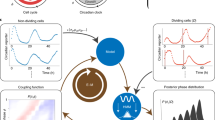Abstract
Cell proliferation is considered a periodic process governed by a relaxation timer. The collective behavior of a system composed of three identical relaxation oscillators in numerically studied under the condition that diffusion of the slow mode dominates. We demonstrate: (1) the existence of three periodic regimes with different periods and phase relations and an unsymmetrical, stable steady-state (USSS); (2) the coexistence of in-phase oscillations and USSS; (3) the coexistence of periodic attractors; and (4) the emergence of a two-loop limit cycle coexisting with both in-phase oscillations and a stable steady-state. The qualitative reasons for such a diversitiy and its possible role in the generation of cell cycle variability are discussed.
Similar content being viewed by others
References
Aronson DG, Doedel EJ, Othmer HG (1987) An analytical and numerical study of the bifurcations in a system of linearly-coupled oscillators. Physica 25D:20–104
Ashwin P, King GP, Swift JW (1990) Three identical oscillators with symmetrical coupling. Nonlinearity 3:585–601
Baesens C, Guckenheimer J, Kim S, MacKey RS (1991) Three coupled oscillators: mode-locking, global bifurcations and toroidal chaos. Physica 49D:387–475
Bar-Eli KJ (1984a) Coupling of chemical oscillators. J Phys Chem 88:3616–3622
Bar-Eli KJ (1984b) The dynamics of coupled chemical oscillators. J Phys Chem 88:6174–6177
Bar-Eli K (1990) Coupling of identical chemical oscillators. J Phys Chem 94:2368–2374
Bar-Eli K, Reuveni SY (1985) Stable stationary states of coupled chemical oscillators. J Phys Chem 89:1329–1330
Brooks RF, Riddle PN (1988) Differences in growth factor sensitivity between individual 3T3 cells arise at high frequency:possible relevance to cell senescence. Exp Cell Res 174:378–387
Chernavskii DS, Palamarchuk EK, Polezhaev AA, Solyanik GI, Burlakova EB (1977) A mathematical model of periodic processes in membranes (with application to cell cycle regulation). BioSystems 9:187–193
Crowley MF, Epstein IR (1989) Experimental and theoretical studies of coupled chemical oscillators:phase death, multistability, and in-phase and out-of-phase entrainment. J Phys Chem 93:2496–2502
Doedel EJ (1981) AUTO:a program for the automatic bifurcation analysis of autonomous systems. Cong Num 30:265–284
Dolnik M, Marek MY (1988) Extinction of oscillators in forced and coupled reaction cells. J Phys Chem 92:2452–2455
Epstein IR (1990) Coupled oscillators in chemistry and biology. Comment Mol Cell Biophys 6:299–327
Grasman J, Jansen MJW (1979) Mutually synhronized relaxation oscillators as prototypes of oscillating systems in biology. J Math Biol 7:171–197
Hairer E, Wanner G (1990) Solving ordinary differential equations. II. Stiff and differential-algebraic problems. (Springer Series in Computational Mathematics) Springer, Berlin Heidelberg New York
Helfand E (1979) Numerical integration of stochastic differential equations. Bell Sys Tech J 58:2289–2299
Mustafin AT, Volkov EI (1984) The role of lipid and antioxidant exchanges in cell division synchronization (mathematical model). Biol Cybern 49:149–154
Petrovic AC, Oudet CL, Stutzmann JJ (1984) Temporal organization of rat and human skeletal cells. In:Edmunds LNJ (ed) Cell cycle clocks. Marcel Dekker, New York
Pol van der, Mark van der (1928) The heartbeat considered as a relaxation oscillation, and an electrical model of the heart. Philos Mag 6:763–775
Prigogine I, Lefever R (1968) Symmetry breaking instabilities in dissipative systems. J Chem Phys 48:1665–1700
Schimtz A, Hildebrand E (1992) Non-random structures in the locomotor behaviour of Halobacterium: a bifurcation route to chaos. Proc Natl Acad Sci USA 89:457–460
Tyson J, Kauffman SI (1975) Control of mitosis by continuous biochemical oscillation:synchronization; spatially inhomogenous oscillations. J Math Biol 1:289–310
Volkov EI, Mustafin AT (1985) Mathematical model of the lipid peroxidation in membranes. Proc Acad Sci USSR [Biol] 6:805–821
Volkov EI, Pertsova TB (1987) Formation of a frequency trigger in a system of interacting relaxation oscillators. Soviet Physics Lebedev Institute Reports 11:48–51
Volkov EI, Stolyarov MN (1991) Birhythmicity in a system of two coupled identical oscillators. Phys Lett 159A:61–66
Volkov EI, Stolyarov MN, Brooks RF (1991) The modelling of heterogeneity in proliferative capacity during clonal growth. In: Volkov EI (ed) Biophysical approach to complex biological phenomena. Nova Science Publishers, New York
Winfree AT (1967) Biological rhythms and the behavior of populations of coupled oscillators. J Theor Biol 16:15–42
Yoshimoto M, Yoshikawa K, Mori Y (1993) Coupling among three chemical oscillators:synchronization, phase death, and frustration. Phys Rev 47E:864–874
Author information
Authors and Affiliations
Rights and permissions
About this article
Cite this article
Volkov, E.I., Stolyarov, M.N. Temporal variability in a system of coupled mitotic timers. Biol. Cybern. 71, 451–459 (1994). https://doi.org/10.1007/BF00198921
Received:
Accepted:
Issue Date:
DOI: https://doi.org/10.1007/BF00198921




